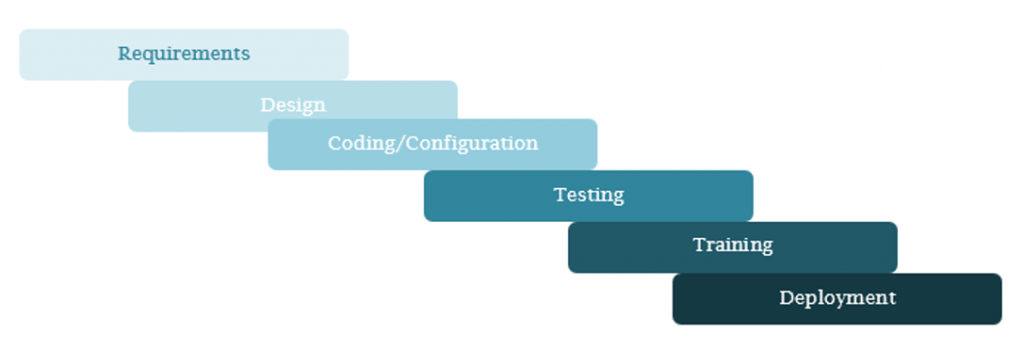
By Ian Hobkirk
Managing Director of Commonwealth Supply Chain Advisors
Every Warehouse Management System (WMS) vendor uses its own WMS implementation approach, with most opting for one of two basic options: Classic waterfall or rapid deployment. In this blog, we’ll look at both and help you decide which might be the best fit for your company.
WMS Implementation Approach #1: Classic Waterfall
The waterfall methodology is the oldest and most popular project methodology. As you can see in the diagram below, it’s a sequential process that begins with a determination of the requirements for the project and ends with a “big bang” go-live.
These projects typically have discrete milestones or “stage gates,” that come with predefined timelines. The typical stages of a waterfall style project are: requirements definition, detailed design, coding and/or configuration, testing, training, and deployment.
As you can see, this is a linear methodology, which means decisions or misses that occur early on can negatively impact later steps. For example, if a critical interface message design was missed and not discovered until testing, deployment must be delayed until the message is coded and tested.
Figure 1: Classic Waterfall Methodology
WMS Implementation Approach #2: Rapid Deployment
Think of the rapid deployment implementation as being circular or “trial and error” in nature. As you can see from the diagram below, this methodology begins with installing the WMS and immediately training a core group of client users. Depending on how closely the base implementation meets its operational needs, the company may decide to immediately go live with the system or may decide to build/configure additional functionality.
By using the system, the client determines what it needs and when to deploy it. Thus, we typically see a series of discover, build/configure, and test cycles. It’s important to note that the rapid deployment model dictates that the new WMS must operate in parallel with the company’s current processes or systems. That said, if any major problems occur during deployment, the operation can easily fall back on its existing systems while those issues are cleared up.
Figure 2: Rapid Deployment Methodology
Two Paths to the Same Goal
Both classic waterfall and rapid deployment implementations achieve the same goal, yet they take different paths to get there. Most IT departments I’ve worked with are comfortable with the waterfall methodology but less so with the rapid deployment methodology. This is something to be aware of because if problems crop up between the vendor and company’s IT department, for example, project time lines may be extended and additional costs incurred.
Of the two different implementation options we’re discussing here, classic waterfall is most easily understood and accepted in IT organizations. It’s also easy to communicate milestones and track costs. Thus, when building the team and outlining task responsibilities, it is easier to define when certain tasks should start and to estimate timelines.
The drawbacks to the waterfall methodology are twofold. Along with the misses that can interfere with timeline and cost, there is typically a high upfront cost before the organization starts to get a return on investment (ROI). This cost may be too much for small companies to bear, forcing them to turn to rapid deployment.
The major benefits of the rapid deployment methodology—an approach that’s often used by cloud-based WMS providers—are lower upfront costs and a shorter time to value. The downside is that the functionality is not fully assessed and documented prior to building or configuring the system. This can result in a significant amount of rework.
There’s No Magic Bullet
I generally see larger companies using the waterfall methodology and smaller companies turning to the rapid deployment model (although many smaller companies still opt for the waterfall methodology and vice versa). This likely has more to do with the complexity and extensiveness of the requirements than anything else. A small company will often have less complex distribution requirements than a large company—especially in the retail arena, where multi-channel distribution is becoming more prevalent. There’s no one right methodology that every company can use. By assessing your firm’s needs well in advance and understanding your own IT team’s capabilities and limitations, you’ll be able to make the best WMS implementation decisions.


